Key Takeaways
1. Prioritize wisely: Set systems, not goals
"Instead of saying, for example, "My goal is to write 100,000 words," I reframe it and say, "My system is that every morning for an hour I'm going to write 500 words." And eventually that's going to amount to 100,000 words, but you don't think of it that way. You think of it as a system."
Systems over goals. Instead of setting traditional goals, focus on creating systems that lead to desired outcomes. This approach reduces the pressure of constant "failure" until the goal is reached and provides a more sustainable path to achievement.
Practical implementation:
- Identify your desired outcome
- Design a daily or weekly system that moves you towards that outcome
- Focus on consistently following the system rather than fixating on the end goal
By shifting focus from the end result to the process, you'll likely find increased motivation and a greater sense of accomplishment along the way.
2. Structure your day for peak performance
"I changed my schedule so that on writing days, I set myself a word count and in the morning I'll say, "Okay, today I have to write 700 words" and I won't bring my phone into the office with me, I will not open up my email, I will not do anything until I hit those 700 words and then I'm free to do other things."
Optimize your chronotype. Understanding your natural energy rhythms (chronotype) can significantly improve productivity. Structure your day to align with your peak cognitive periods for maximum efficiency.
Key strategies:
- Identify your chronotype (lark, middle bird, or owl)
- Schedule deep work during your peak cognitive hours
- Use lower energy periods for less demanding tasks
- Implement regular breaks to maintain focus and energy
- Create location-based rituals to reinforce productive habits
By aligning your work schedule with your natural rhythms and creating supportive environments, you can dramatically increase your productivity and work satisfaction.
3. Boost efficiency through automation and meeting optimization
"There is a standard idea from outsourcing thinking that if you're going to do something more than thirty times a year, then it's worth automating or outsourcing."
Automate and optimize. Identify repetitive tasks and implement strategies to streamline or eliminate them. This frees up time and mental energy for more important work.
Efficiency boosters:
- Apply the 30x rule: Automate or outsource tasks done more than 30 times a year
- Use tools like Zapier or Keyboard Maestro for task automation
- Implement asynchronous communication (e.g., video updates) to reduce meeting time
- Batch similar tasks to minimize context switching
- Create templates for recurring tasks or communications
By systematically reducing time spent on low-value activities, you create space for high-impact work and strategic thinking.
4. Enhance focus by taming digital distractions
"I deleted Facebook, Instagram, YouTube, Twitter and Gmail from my phone. I even turned off Safari."
Digital detox for focus. Our devices, while useful, can be significant sources of distraction. Implementing strategies to reduce digital interruptions can dramatically improve focus and productivity.
Distraction-taming techniques:
- Remove non-essential apps from your phone
- Use "Do Not Disturb" modes during focused work periods
- Implement website blockers during work hours
- Create physical distance between you and your devices
- Schedule specific times for email and social media checks
By consciously designing your digital environment, you can reclaim your attention and direct it towards meaningful work and personal interactions.
5. Reflect regularly to overcome self-doubt and grow
"I'm happy that I still get very nervous, even if I maybe shouldn't be. If there ever was a day where I was like, "Yeah, I should totally be here" – I don't want to be like that. I want to always be looking at myself and questioning where I am right now in my career."
Embrace self-reflection. Regular introspection can help overcome imposter syndrome, identify areas for growth, and maintain a growth mindset. View self-doubt as a motivator rather than a hindrance.
Reflection strategies:
- Schedule bi-annual "life check-ups" to assess career satisfaction and growth
- Reframe self-doubt as an opportunity for improvement
- Seek specific, actionable feedback from peers and mentors
- Keep a "Spark Joy" folder of accomplishments and positive feedback
- Use self-doubt as a signal to pursue challenging opportunities
By cultivating a habit of thoughtful reflection, you can turn potential stumbling blocks into stepping stones for personal and professional growth.
6. Build stronger connections through strategic networking
"There is extraordinary power in our existing networks. And arguably, the most impactful thing that most people can do to improve their network is to reinvigorate dormant ties."
Leverage existing connections. Rather than focusing solely on making new connections, invest time in rekindling and strengthening existing relationships. This approach can lead to unexpected opportunities and support.
Networking strategies:
- Regularly reach out to dormant contacts with a simple "thinking of you" message
- Share relevant content or opportunities with your network
- Ask for advice or offer help to deepen connections
- Use the "Next Tuesday" rule when evaluating networking opportunities
- Practice "extreme giving" by looking for ways to support others
By approaching networking with a mindset of genuine connection and mutual support, you can build a robust and beneficial professional ecosystem.
7. Maintain energy by cultivating joy and eliminating irritants
"I'll put a rotating bunch of items that spark joy in it. It could be a family photo, it could be a paper I recently published, or a comment from a speaking host that gave me praise on something I did, or a positive teaching evaluation. I'll go into that folder usually at least once a day and just read a couple things. It helps me feel good about one of the things that I've been able to do."
Prioritize joy and eliminate friction. Consciously incorporating elements that bring joy and removing recurring irritants can significantly boost your energy and productivity.
Energy-boosting tactics:
- Create a "Spark Joy" folder of positive feedback and accomplishments
- Identify and eliminate recurring irritants in your work and personal life
- Inject humor into serious work to maintain perspective and reduce stress
- Use the "Tiny Habits" method to build positive routines
- Practice gratitude through daily rituals or visual reminders
By actively managing your emotional and energetic state, you can maintain higher levels of motivation and resilience, leading to more consistent productivity and satisfaction in your work and life.
Last updated:
FAQ
What's Time Wise about?
- Focus on Productivity: Time Wise by Amantha Imber delves into mastering daily productivity through the habits of highly effective individuals. It compiles insights from over 150 interviews with successful people across various fields.
- Practical Strategies: The book offers research-backed strategies to enhance productivity, work efficiency, and overall joy. It's designed for anyone looking to manage their time better, from CEOs to students.
- Seven Key Categories: Content is organized into seven categories: Priorities, Structure, Efficiency, Focus, Reflection, Connection, and Energy, each providing actionable advice to optimize time.
Why should I read Time Wise?
- Actionable Insights: The book is filled with practical ideas that can be implemented immediately to improve time management. It's based on real-life experiences rather than just theory.
- Diverse Perspectives: By drawing from a wide range of successful people, it offers various strategies, allowing readers to find methods that resonate with their personal circumstances.
- Reduce Stress and Increase Joy: Imber emphasizes that wise time use can lead to less stress and greater joy, making it valuable for anyone feeling overwhelmed by daily responsibilities.
What are the key takeaways of Time Wise?
- Set Systems, Not Goals: Focus on creating systems for consistent progress rather than traditional goal-setting. This approach helps maintain motivation and reduces feelings of failure.
- Prioritize Your Time: Use decision-making heuristics to determine valuable tasks and commitments, helping you focus on what matters most.
- Embrace Work-Life Imbalance: Strive for a work-life imbalance that favors activities you love, leading to greater satisfaction and fulfillment.
What specific methods does Time Wise recommend for improving focus?
- Chronotype Awareness: Understand your chronotype to schedule important tasks during peak energy times, ensuring productivity when you're most alert.
- The Hemingway Trick: Finish your workday halfway through a task to make it easier to start again the next day, maintaining momentum.
- Scheduled Breaks: Regularly schedule breaks to recharge and maintain focus, as short breaks can improve productivity and mental clarity.
How does Time Wise suggest handling meetings?
- Eliminate Unnecessary Meetings: Critically assess the necessity of each meeting and eliminate those that don't add value, freeing up time for important tasks.
- Batch Meetings: Group meetings together to create dedicated blocks of time, allowing for uninterrupted focus on other work during the rest of the day.
- Set Clear Agendas: Ensure every meeting has a clear agenda and purpose communicated in advance, keeping discussions focused and efficient.
What is the Iceberg Yes concept in Time Wise?
- Understanding Commitment: The Iceberg Yes concept involves looking beyond visible excitement to assess the hidden workload of new commitments.
- Avoid Overcommitment: Recognize the full scope of commitments to avoid feeling overwhelmed, encouraging a thoughtful approach to new opportunities.
- Visualizing the Workload: Think of the visible part of the iceberg as exciting aspects, while the hidden part represents the time and effort required.
What are some effective strategies for reducing digital distractions mentioned in Time Wise?
- Use a kSafe: Lock your phone away in a kSafe for designated periods to eliminate the temptation to check it, helping focus on work.
- Rubber Band Trick: Place a rubber band around your phone as a visual cue to pause and consider if you really need to use it, reducing mindless checking.
- Designate Stopping Cues: Establish specific times or situations when you won't use your phone, creating boundaries and encouraging meaningful interactions.
What is the significance of the Might-Do list in Time Wise?
- Optional Task Management: The Might-Do list categorizes non-urgent tasks, giving freedom to choose whether to tackle them, reducing pressure.
- Focus on Priorities: By separating less important tasks, you can concentrate on what truly matters without guilt over unfinished tasks.
- Batch Processing: Schedule dedicated time to address accumulated tasks, making administrative work feel less daunting and more manageable.
How can I implement the "Struggle Timer" from Time Wise?
- Set a Timer: When stuck on a task, set a timer for five to ten minutes to create urgency and encourage focus.
- Push Through Negative Emotions: Use this time to confront discomfort or frustration, often leading to breakthroughs in focus.
- Evaluate Afterward: If still stuck after the timer, take a break, but the timer often helps regain productive flow.
What are some practical tips for reducing distractions mentioned in Time Wise?
- Phone Management: Keep your phone out of reach during work hours to minimize distractions, significantly improving focus.
- Creating a Distraction-Free Environment: Designate specific areas for work and relaxation, creating mental boundaries and reducing non-work temptations.
- Using Music for Focus: Listen to specific songs or playlists to trigger a flow state, associating music with productivity over time.
What are the best quotes from Time Wise and what do they mean?
- “The bad news is time flies. The good news is you’re the pilot.”: Emphasizes taking control of your time and making conscious choices about how you spend it.
- “We are not given a short life but we make it short, and we are not ill-supplied but wasteful of it.”: Highlights that time scarcity often stems from poor management, encouraging mindfulness.
- “If you have your entire day pre-booked with meetings, it leaves no room whatsoever for real life to happen.”: Advocates for leaving space in your schedule for spontaneity and creativity.
How does Time Wise address procrastination?
- Understanding Procrastination: Reframes procrastination as an emotional management issue, encouraging exploration of underlying feelings.
- Strategies to Overcome It: Provides techniques like the "Struggle Timer" and "To-Don't" lists to combat procrastination by breaking tasks into manageable steps.
- Emphasizing Self-Compassion: Encourages forgiving oneself for procrastinating, reducing guilt and leading to more productive behaviors.
Review Summary
Time Wise receives mixed reviews, with an average rating of 3.65/5. Readers appreciate its practical tips for time management and productivity, especially for office workers. Many find the book's structure and summaries helpful. However, some criticize it as repetitive, simplistic, or geared towards privileged individuals. Positive reviewers praise its straightforward writing and actionable strategies, while critics argue it lacks originality and depth. The book's effectiveness seems to vary based on readers' prior knowledge of time management techniques and their specific work environments.
Similar Books









Download PDF
Download EPUB
.epub digital book format is ideal for reading ebooks on phones, tablets, and e-readers.




